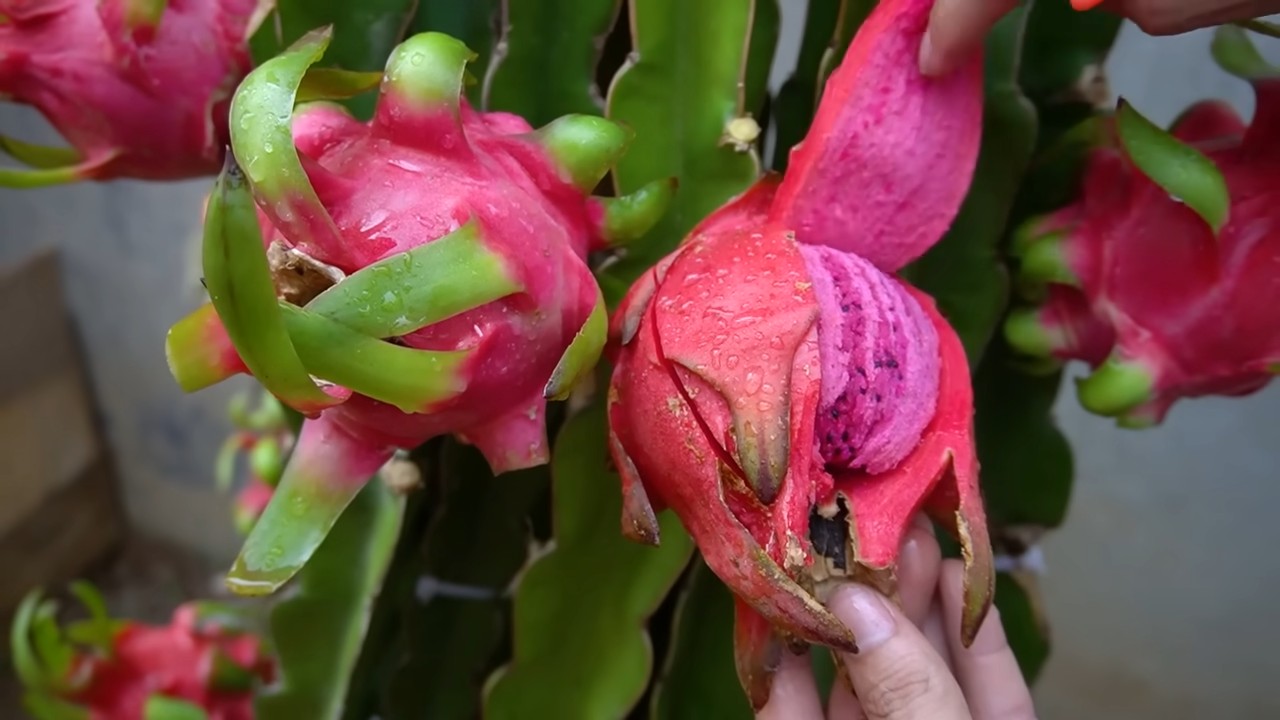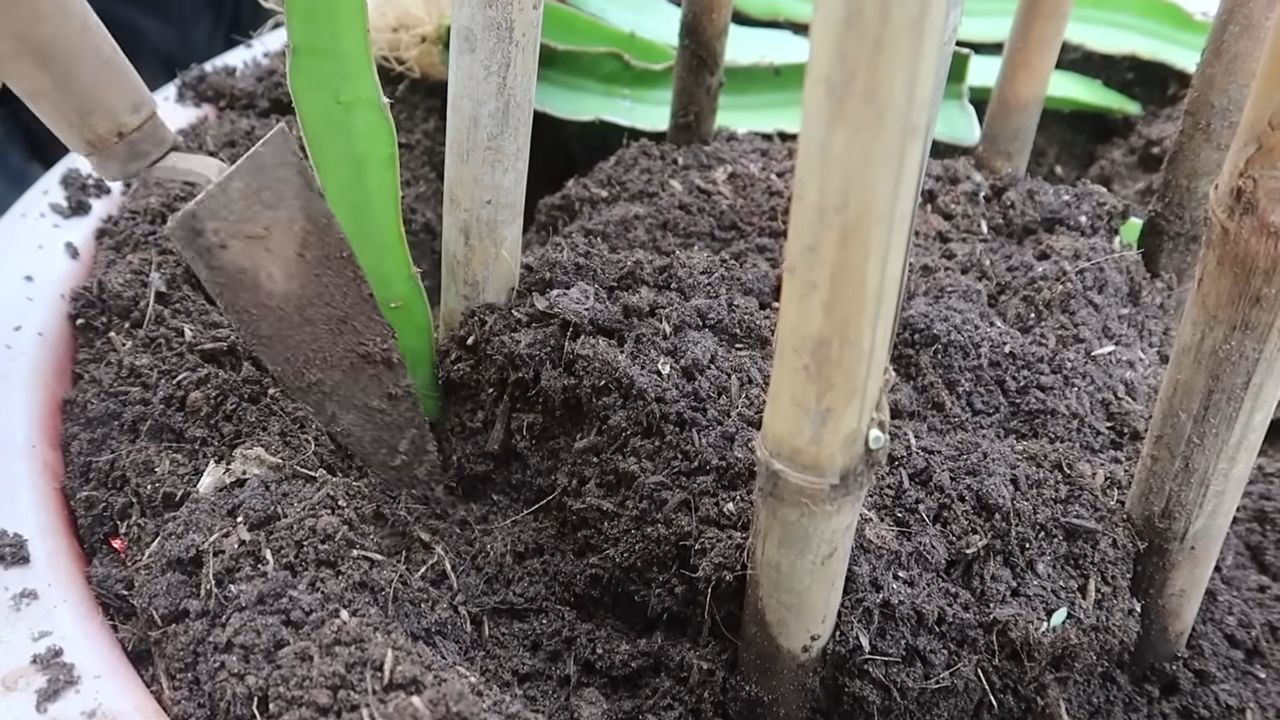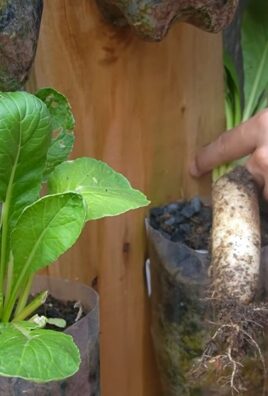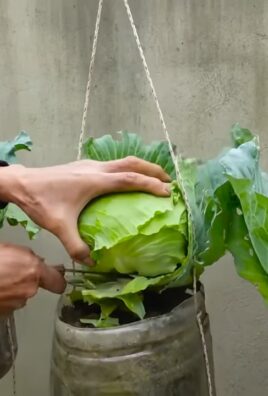Growing Red Dragon Fruit at home might sound like an exotic dream, reserved for tropical climates and expert gardeners. But guess what? I’m here to tell you that with a few clever tricks and a dash of DIY spirit, you can absolutely cultivate this vibrant and delicious fruit in your own backyard or even on your balcony!
For centuries, the Red Dragon Fruit, also known as Pitaya, has been cherished in Southeast Asia and Latin America, not only for its striking appearance but also for its refreshing taste and numerous health benefits. Imagine the satisfaction of harvesting your own organically grown dragon fruit, knowing exactly where it came from and how it was nurtured.
But why should you bother with this DIY project? Well, store-bought dragon fruit can be expensive and sometimes lack the intense flavor of a freshly picked one. Plus, growing Red Dragon Fruit yourself is incredibly rewarding! It’s a fantastic way to connect with nature, learn about plant life, and impress your friends and family with your gardening prowess. This article will guide you through simple, effective DIY hacks that will make growing your own dragon fruit a fun and successful adventure, regardless of your experience level. So, let’s get started and transform your space into a mini-tropical paradise!

DIY: Propagating Red Dragon Fruit from Cuttings
Okay, dragon fruit lovers! So you’re ready to multiply your dragon fruit bounty without breaking the bank? I’m here to guide you through the surprisingly simple process of propagating red dragon fruit from cuttings. Trust me, it’s easier than you think, and the reward of seeing those little cuttings sprout and thrive is incredibly satisfying. Let’s get started!
What You’ll Need
Before we dive in, let’s gather our supplies. Having everything ready beforehand will make the whole process smoother.
* Healthy Red Dragon Fruit Cuttings: This is the most crucial part! You’ll want cuttings that are at least 12 inches long, preferably 18-24 inches. Look for healthy, mature stems that are green and plump, not shriveled or damaged. Avoid cuttings from the very tip of the plant, as these tend to be less vigorous.
* Sharp, Clean Pruning Shears or Knife: Sterilize your cutting tool with rubbing alcohol to prevent the spread of disease. A clean cut is essential for healthy rooting.
* Rooting Hormone (Optional but Recommended): While dragon fruit roots relatively easily, rooting hormone can significantly speed up the process and increase your success rate. I personally prefer using a powdered rooting hormone.
* Well-Draining Potting Mix: Dragon fruit hates soggy soil! A mix specifically designed for cacti and succulents is ideal. You can also create your own by combining equal parts potting soil, perlite, and coarse sand.
* Pots: Choose pots that are at least 6 inches in diameter. Make sure they have drainage holes!
* Watering Can or Hose: For gentle watering.
* Gloves (Optional): Dragon fruit stems can have small spines, so gloves can protect your hands.
* Labels: To keep track of your cuttings (especially if you’re propagating multiple varieties).
* A Sunny Location: Dragon fruit loves sunshine!
Preparing the Cuttings
This step is all about setting your cuttings up for success.
1. Select Your Cuttings: As mentioned before, choose healthy, mature stems. Look for sections that are at least 12 inches long. I usually aim for 18-24 inches for better stability when planting.
2. Make the Cuts: Using your sterilized pruning shears or knife, make clean, angled cuts at both ends of the cutting. An angled cut helps prevent water from pooling on the cut surface, which can lead to rot. Make sure the bottom cut is clearly distinguishable from the top cut.
3. Allow the Cuttings to Callus: This is a crucial step! Place the cuttings in a dry, shaded area for 5-7 days to allow the cut ends to callus over. This helps prevent fungal infections and rot. The cut ends should form a hardened layer. Don’t skip this step! I’ve learned the hard way that skipping this leads to a higher failure rate.
4. Apply Rooting Hormone (Optional): If you’re using rooting hormone, now’s the time. Moisten the bottom inch or two of the cutting with water, then dip it into the rooting hormone powder. Tap off any excess powder.
Planting the Cuttings
Now for the fun part – getting those cuttings into the soil!
1. Fill the Pots: Fill your pots with the well-draining potting mix, leaving about an inch of space at the top.
2. Plant the Cuttings: Insert the calloused end of the cutting into the soil, burying it about 2-3 inches deep. Make sure the cutting is upright and stable. You can use a small stake to support it if needed.
3. Water Gently: Water the cuttings gently until the soil is moist but not soggy. Avoid overwatering, as this can lead to rot.
4. Label Your Pots: Don’t forget to label each pot with the date and variety of dragon fruit. This will help you keep track of your progress.
Caring for Your Cuttings
This is where patience comes in. It can take several weeks or even months for the cuttings to root.
1. Provide Bright, Indirect Light: Place the pots in a location that receives bright, indirect sunlight. Avoid direct sunlight, especially during the hottest part of the day, as this can scorch the cuttings.
2. Water Sparingly: Dragon fruit is drought-tolerant, so it’s better to underwater than overwater. Water only when the soil is dry to the touch. I usually check the soil moisture every few days by sticking my finger into the soil.
3. Maintain Warm Temperatures: Dragon fruit thrives in warm temperatures (70-85°F). Avoid exposing the cuttings to cold drafts or freezing temperatures.
4. Be Patient: It can take several weeks or even months for the cuttings to root. Don’t be discouraged if you don’t see any new growth right away. Check for root development by gently tugging on the cutting. If it resists, it has likely rooted.
5. Fertilize (Optional): Once the cuttings have rooted and started to show new growth, you can start fertilizing them with a balanced fertilizer diluted to half strength. I usually fertilize every 2-3 weeks during the growing season (spring and summer).
Transplanting Your Dragon Fruit
Once your cuttings have developed a strong root system and are showing healthy new growth, it’s time to transplant them into larger pots or into the ground.
1. Choose a Suitable Location: Dragon fruit needs plenty of sunlight (at least 6-8 hours per day) and well-draining soil. If you’re planting in the ground, choose a location that is protected from strong winds.
2. Prepare the Soil: Amend the soil with compost or other organic matter to improve drainage and fertility.
3. Dig a Hole: Dig a hole that is slightly larger than the root ball of the dragon fruit plant.
4. Carefully Remove the Plant from the Pot: Gently loosen the soil around the edges of the pot and carefully remove the plant. Be careful not to damage the roots.
5. Place the Plant in the Hole: Place the plant in the hole, making sure the top of the root ball is level with the surrounding soil.
6. Fill the Hole with Soil: Fill the hole with soil and gently firm it around the plant.
7. Water Thoroughly: Water the plant thoroughly after planting.
8. Provide Support: Dragon fruit is a climbing plant, so it will need support to grow properly. You can use a trellis, a post, or a fence. I personally use a sturdy post with a tire on top for the dragon fruit to cascade over.
9. Mulch: Apply a layer of mulch around the base of the plant to help retain moisture and suppress weeds.
Ongoing Care
Congratulations! You’ve successfully propagated and transplanted your red dragon fruit. Now, let’s talk about ongoing care to ensure your plant thrives and produces delicious fruit.
* Watering: Water deeply but infrequently, allowing the soil to dry out between waterings. Dragon fruit is drought-tolerant, so it’s better to underwater than overwater.
* Fertilizing: Fertilize regularly during the growing season (spring and summer) with a balanced fertilizer. I usually fertilize every 2-3 weeks.
* Pruning: Prune your dragon fruit plant regularly to remove dead or damaged stems and to encourage branching.
* Pest and Disease Control: Keep an eye out for pests and diseases, such as aphids, mealybugs, and fungal infections. Treat any problems promptly.
* Pollination: Most red dragon fruit varieties are self-pollinating, but hand-pollination can increase fruit set. Use a small paintbrush to transfer pollen from one flower to another. I usually do this in the evening when the flowers are fully open.
* Harvesting: Dragon fruit is typically ready to harvest about 30-50 days after flowering. The fruit should be bright red and slightly soft to the touch.
Troubleshooting
Even with the best care, you might encounter some challenges along the way. Here are a few common problems and how to address them:
* Cuttings Not Rooting: This could be due to several factors, including poor quality cuttings, improper callusing, overwatering, or insufficient light. Make sure you’re using healthy cuttings, allowing them to callus properly, watering sparingly, and providing bright, indirect light.
* Cuttings Rotting: This is usually caused by overwatering or fungal infections. Make sure you’re using well-draining potting mix and watering only when the soil is dry to the touch. You can also treat the cuttings with a fungicide.
* Yellowing Leaves: This could be a sign of overwatering, underwatering, nutrient deficiency, or pest infestation. Check the soil moisture, fertilize if necessary, and inspect the plant for pests.

Conclusion
So, there you have it! Growing Red Dragon Fruit at home, while it might seem like an exotic endeavor, is surprisingly achievable with a little patience, the right knowledge, and a touch of DIY ingenuity. We’ve explored the ins and outs of creating the perfect growing environment, from crafting the ideal soil mix to constructing sturdy support structures. But the real magic lies in the satisfaction of nurturing a plant from a small cutting or seed to a fruit-bearing marvel.
Why is this DIY approach a must-try? Because it empowers you to control every aspect of your dragon fruit’s growth. You dictate the quality of the soil, ensuring it’s free from harmful chemicals and packed with the nutrients your plant craves. You tailor the watering schedule to your specific climate and the needs of your dragon fruit. And, perhaps most importantly, you connect with nature in a deeply rewarding way. There’s nothing quite like harvesting a vibrant, ruby-red dragon fruit that you’ve personally cultivated.
But the journey doesn’t end here! Feel free to experiment with different variations to personalize your dragon fruit growing experience. Try incorporating organic amendments like compost tea or worm castings to boost nutrient levels. Explore different trellis designs to optimize sunlight exposure and airflow. Consider grafting different varieties of dragon fruit onto a single plant to create a unique and diverse harvest. You can even try growing your dragon fruit indoors with the help of grow lights, bringing a touch of the tropics into your home.
Remember, growing Red Dragon Fruit is a learning process. Don’t be discouraged by setbacks. Embrace the challenges, learn from your mistakes, and celebrate your successes. The rewards – both in terms of delicious fruit and personal satisfaction – are well worth the effort.
We wholeheartedly encourage you to embark on this exciting DIY adventure. Take the plunge, get your hands dirty, and experience the joy of growing your own Red Dragon Fruit. And, most importantly, share your journey with us! We’d love to hear about your successes, your challenges, and any unique tips or tricks you discover along the way. Post your photos, share your stories, and let’s build a community of passionate dragon fruit growers. Happy growing!
Frequently Asked Questions (FAQ)
What is the best time of year to start growing Red Dragon Fruit?
The ideal time to start growing Red Dragon Fruit is during the spring or early summer. This allows the plant to establish itself and develop a strong root system before the cooler months arrive. In warmer climates, you can potentially start growing dragon fruit year-round, but spring and summer offer the most favorable conditions for initial growth.
How much sunlight does Red Dragon Fruit need?
Red Dragon Fruit thrives in full sun, requiring at least 6-8 hours of direct sunlight per day. Adequate sunlight is crucial for healthy growth, flowering, and fruit production. If you live in an area with intense summer heat, providing some afternoon shade can prevent sunburn on the stems.
What type of soil is best for growing Red Dragon Fruit?
Red Dragon Fruit prefers well-draining soil that is rich in organic matter. A slightly acidic to neutral pH (6.0-7.0) is ideal. A good soil mix can be created by combining equal parts of potting soil, compost, and perlite or sand. This combination provides the necessary drainage, aeration, and nutrients for healthy growth.
How often should I water my Red Dragon Fruit plant?
Water your Red Dragon Fruit plant regularly, especially during the growing season (spring and summer). Allow the soil to dry out slightly between waterings. Overwatering can lead to root rot, so it’s important to ensure proper drainage. Reduce watering frequency during the dormant season (fall and winter).
What kind of support structure does Red Dragon Fruit need?
Red Dragon Fruit is a climbing cactus and requires a sturdy support structure to grow properly. A strong trellis, post, or fence can be used. The support should be at least 5-6 feet tall to accommodate the plant’s growth. As the plant grows, tie the stems to the support to encourage vertical growth. A circular trellis at the top is ideal for the plant to cascade over and produce fruit.
How long does it take for Red Dragon Fruit to produce fruit?
Red Dragon Fruit plants typically start producing fruit within 6-18 months of planting, depending on the variety, growing conditions, and the size of the initial cutting or seedling. Grafted plants may fruit even sooner. Consistent watering, fertilization, and adequate sunlight are essential for early fruit production.
What are some common pests and diseases that affect Red Dragon Fruit?
Common pests that can affect Red Dragon Fruit include aphids, mealybugs, and scale insects. These pests can be controlled with insecticidal soap or neem oil. Root rot is a common disease, which can be prevented by ensuring proper drainage and avoiding overwatering. Fungal diseases can also occur, especially in humid environments. Applying a fungicide can help prevent and treat these diseases.
How do I pollinate Red Dragon Fruit flowers?
Red Dragon Fruit flowers are nocturnal and typically open at night. While some varieties are self-pollinating, others require cross-pollination to produce fruit. If you’re unsure whether your variety is self-pollinating, it’s best to hand-pollinate the flowers. Use a small brush to transfer pollen from the stamen (male part) of one flower to the pistil (female part) of another flower. The best time to hand-pollinate is in the early morning, shortly after the flowers open.
How do I know when Red Dragon Fruit is ripe?
Red Dragon Fruit is typically ripe when the skin turns a vibrant, even color (usually red or pink, depending on the variety) and the “wings” or bracts on the fruit start to dry and wither. The fruit should also feel slightly soft to the touch, similar to a ripe avocado. Gently twist the fruit; if it comes off the vine easily, it’s ready to harvest.
Can I grow Red Dragon Fruit in a container?
Yes, Red Dragon Fruit can be successfully grown in a container, especially if you live in a colder climate where you need to bring the plant indoors during the winter. Choose a large container (at least 20 gallons) with good drainage. Use a well-draining potting mix and provide a sturdy support structure for the plant to climb. Container-grown dragon fruit may require more frequent watering and fertilization than plants grown in the ground.
What fertilizer should I use for Red Dragon Fruit?
Use a balanced fertilizer (e.g., 10-10-10) during the growing season (spring and summer). You can also supplement with organic fertilizers like compost tea or worm castings. Avoid over-fertilizing, as this can damage the plant. Reduce or stop fertilizing during the dormant season (fall and winter).
How do I prune Red Dragon Fruit?
Pruning is important for maintaining the shape and health of your Red Dragon Fruit plant. Remove any dead, damaged, or diseased stems. Prune to encourage branching and improve airflow. You can also prune to control the size and shape of the plant. The best time to prune is after the fruiting season.
Can I grow Red Dragon Fruit from seed?
Yes, you can grow Red Dragon Fruit from seed, but it’s a slower process than growing from cuttings. Extract the seeds from a ripe fruit, wash them thoroughly, and dry them on a paper towel. Sow the seeds in a well-draining seed-starting mix. Keep the soil moist and provide warmth and light. Seedlings can take several weeks to germinate. Be aware that plants grown from seed may not produce fruit that is true to the parent plant.
How do I protect my Red Dragon Fruit plant from frost?
Red Dragon Fruit is sensitive to frost and can be damaged by freezing temperatures. If you live in an area with frost, protect your plant by covering it with a frost blanket or bringing it indoors if it’s grown in a container. You can also wrap the stems with burlap to provide insulation. Avoid watering the plant before a frost, as wet soil can freeze and damage the roots.




Leave a Comment